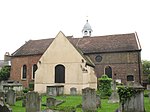Pembroke Lodge, Richmond Park

Pembroke Lodge is an initial, mainstream category listed (Grade II) Georgian two-storey large house in Richmond Park in the London Borough of Richmond upon Thames. It sits on high ground with views across the Thames valley to Windsor, the Chilterns and hills in the Borough of Runnymede. It has 11 acres (4.5 ha) of landscaped grounds, including part of King Henry's Mound from which there is a protected view of St Paul's Cathedral in the City of London. The grounds also include memorials to the 18th-century poet James Thomson and the 20th-century rock-and-roll singer and lyricist Ian Dury. The building is of historical interest, having housed British prime minister Lord John (later, Earl) Russell and the childhood home of his grandson, philosopher and logician Bertrand Russell. GHQ Liaison Regiment ("Phantom") used the premises during World War II. The lodge is part of the Crown Estate and is currently privately run as a catering facility and a conference and wedding venue on a long lease from The Royal Parks. It also houses a heritage charity, The Hearsum Collection.
Excerpt from the Wikipedia article Pembroke Lodge, Richmond Park (License: CC BY-SA 3.0, Authors, Images).Pembroke Lodge, Richmond Park
Queens Road, London Petersham (London Borough of Richmond upon Thames)
Geographical coordinates (GPS) Address Nearby Places Show on map
Geographical coordinates (GPS)
| Latitude | Longitude |
|---|---|
| N 51.4425 ° | E -0.29444444444444 ° |
Address
Pembroke Lodge Gardens
Queens Road
TW10 5HX London, Petersham (London Borough of Richmond upon Thames)
England, United Kingdom
Open on Google Maps








